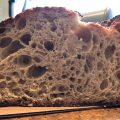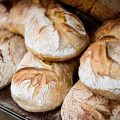Remember the roasted pumpkin seed pesto from the last week? I saved some of it and put it in the sourdough bread – this time with stiff sourdough starter.
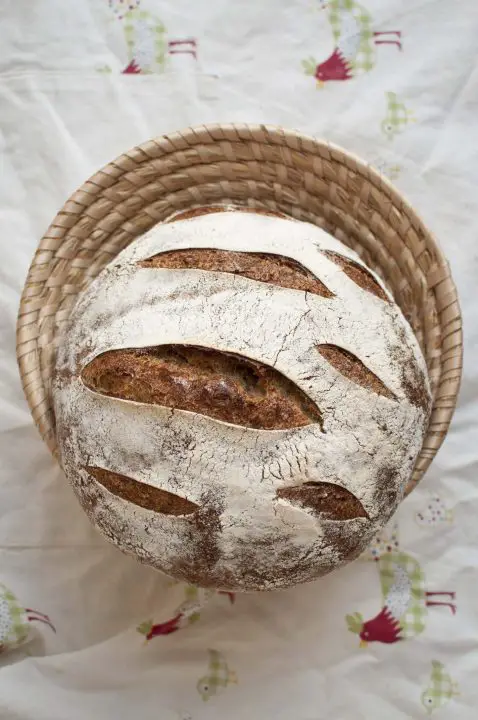
Table of Contents
Print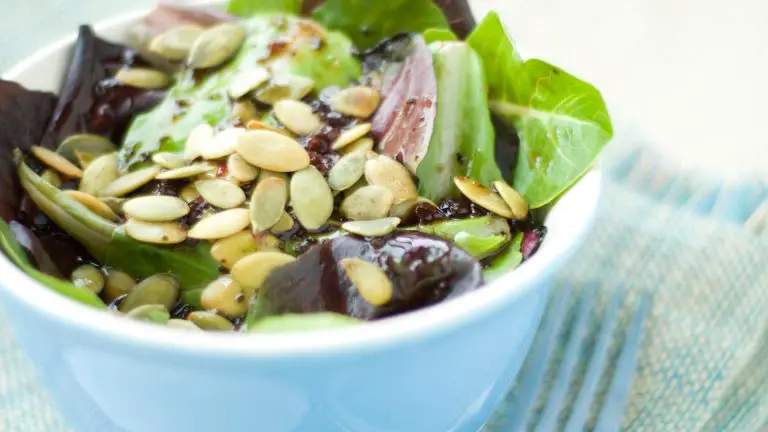
Roasted Pumpkin Seed Pesto Sourdough Bread
- Total Time: 27 hrs 45 mins
- Yield: 1 big loaf 1x
Ingredients
- 400 g white wheat flour
- 280 g water (70 % hydration level)
- 190 g active whole grain wheat stiff sourdough starter (90% hydration)
- 8 g fine sea salt
- 3 tablespoons roasted pumpkin seed pesto
- 1 tablespoon pumpkin seed oil
Instructions
- In the morning of the day you will mix the dough, prepare your sourdough starter. Mix 100 g of whole grain wheat flour with 90 g of water and one teaspoon of your active (or straight from the fridge) sourdough starter and let it ferment until doubled in volume. This is very stiff starter, so its consistency will feel more like a dough and you might not see any rise in the first few hours. If you want to speed up the fermentation, put the jar in a warm spot.
- In the late afternoon, dissolve all of your risen starter in 280 g of water. Next, add 400 of flour and mix all ingredients until they come together. Cover the bowl with the kitchen cloth and let the dough rest for 1 hour (or at least for 30 minutes). Letting your dough to rest after mixing it is a great option if you don’t know how much water your flour absorbs. You can start with less water, let the dough rest and then see if you need to add more water.
- After 1 hour, add 8 g of salt, roasted pumpkin seed pesto, and pumpkin seed oil and then knead the dough for 5 minutes so it becomes stretchy.
- Leave the dough in the bowl to rise for 3 hours at the room temperature (if it’s too cold, you might put the bowl in a slightly warm oven to give the dough a boost to rise properly). Cover the bowl with a kitchen cloth to prevent the surface of the dough from drying out.
- After 3 hours the dough should look very alive, risen, and stretchy. You might even see the bubbles on the dough surface.
- Using your plastic dough scraper, take the dough out on a lightly floured working surface. Pinch the ends of the dough together in the middle, turn the dough upside down and let it rest for 10-15 minutes so that the final shaping will be easier as the gluten will relax.
- In the meantime prepare the rising basket and dust it well. I like to line my rising basket with a kitchen cloth and flour it with white wheat flour.
- To shape the bread, turn it upside down, stretch it a little bit with your fingers and then fold the bottom part over the center, left side over the center, right side over the center and also the upper side over the center. Transfer the dough to the rising basket fold-side up. Sprinkle some more flour on the top and cover it with the rest of the kitchen cloth. Put the basket in the fridge. Let it ferment until the volume of the dough has visibly increased (at least by a third) and when the indent you make with your finger springs back slowly and not all the way up (poking test). If it springs back quickly, leave to ferment longer.
- In the morning, my dough is usually ready, when I wake up (I’ve been practising this for years :)). Normally, you would get up and check how the dough responds to the poking test. If the dough is ready, preheat your oven to the maximum temperature of your oven along with Dutch oven or a baking stone for at least 30 minutes before baking. I used Dutch oven.
- When the oven is preheated, take the loaf out of the rising basket (tip: take a chopping board and put it over the rising basket and then flip everything upside down) and transfer it to Dutch oven. Score the loaf and put your Dutch oven into oven.
- Bake the loaf for 20 minutes with the lid on at 240°C/465F°F and 20-25 minutes with lid off at 230°C/445°F and until bread gets nice golden color.
- Cool on a cooling rack before cutting for at least 1 hour.
Notes
- This bread was mixed in the evening, left to rise for 3 hours at the room temperature, shaped and then put in the fridge for 11 hours. It was baked in the morning of the following day.
- Prep Time: 27 hrs 20 mins
- Cook Time: 25 mins
- Category: bread
Roasted Pumpkin Seed Pesto Sourdough Bread
Baking Schedule
This pesto bread was mixed in the evening, left to rise for 3 hours at the room temperature, shaped and then put in the fridge for 11 hours. It was baked in the morning of the following day.
Ingredients
Yields: one big loaf
- 400 g white wheat flour
- 280 g water (70 % hydration level)
- 190 g active whole grain wheat stiff sourdough starter (90% hydration)
- 8 g fine sea salt
- 3 tablespoons roasted pumpkin seed pesto
- 1 tablespoon pumpkin seed oil
Instructions for Pesto Bread
- In the morning of the day you will mix the dough, prepare your sourdough starter. Mix 100 g of whole grain wheat flour with 90 g of water and one teaspoon of your active (or straight from the fridge) sourdough starter and let it ferment until doubled in volume. This is very stiff starter, so its consistency will feel more like a dough and you might not see any rise in the first few hours. If you want to speed up the fermentation, put the jar in a warm spot.
- In the late afternoon, dissolve all of your risen starter in 280 g of water. Next, add 400 of flour and mix all ingredients until they come together. Cover the bowl with the kitchen cloth and let the dough rest for 1 hour (or at least for 30 minutes). Letting your dough to rest after mixing it is a great option if you don’t know how much water your flour absorbs. You can start with less water, let the dough rest and then see if you need to add more water.
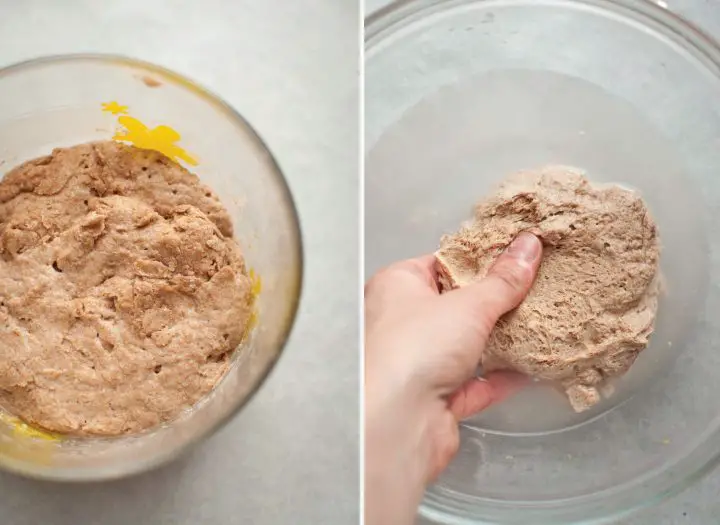
- After 1 hour, add 8 g of salt, roasted pumpkin seed pesto, and pumpkin seed oil and then knead the dough for 5 minutes so it becomes stretchy.
- Leave the dough in the bowl to rise for 3 hours at the room temperature (if it’s too cold, you might put the bowl in a slightly warm oven to give the dough a boost to rise properly). Cover the bowl with a kitchen cloth to prevent the surface of the dough from drying out.
- After 3 hours the dough should look very alive, risen, and stretchy. You might even see the bubbles on the dough surface.
- Using your plastic dough scraper, take the dough out on a lightly floured working surface. Pinch the ends of the dough together in the middle, turn the dough upside down and let it rest for 10-15 minutes so that the final shaping will be easier as the gluten will relax.
- In the meantime prepare the rising basket and dust it well. I like to line my rising basket with a kitchen cloth and flour it with white wheat flour.
- To shape the bread, turn it upside down, stretch it a little bit with your fingers and then fold the bottom part over the center, left side over the center, right side over the center and also the upper side over the center.
- Transfer the dough to the rising basket fold-side up. Sprinkle some more flour on the top and cover it with the rest of the kitchen cloth. Put the basket in the fridge. Let it ferment until the volume of the dough has visibly increased (at least by a third) and when the indent you make with your finger springs back slowly and not all the way up (poking test). If it springs back quickly, leave to ferment longer.
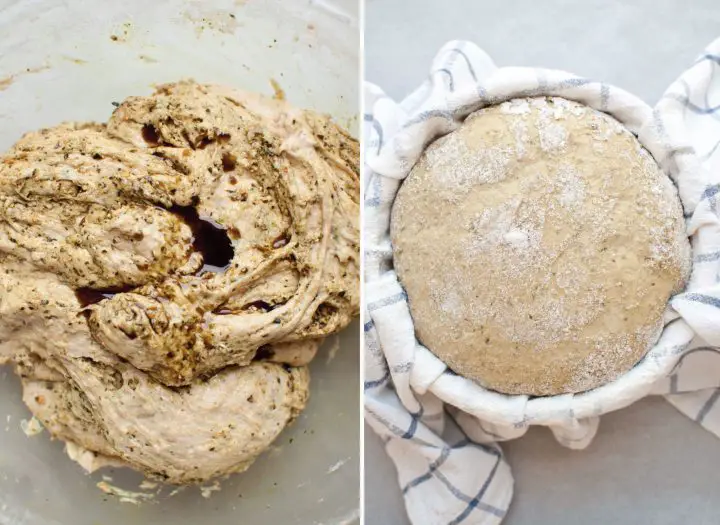
- In the morning, my dough is usually ready, when I wake up (I’ve been precising this for years :)). Normally, you would get up and check how the dough responds to the poking test. If the dough is ready, preheat your oven to the maximum temperature of your oven along with Dutch oven or a baking stone for at least 30 minutes before baking. I used a Dutch oven.
- When the oven is preheated, take the loaf out of the rising basket (Tip: take a chopping board and put it over the rising basket and then flip everything upside down) and transfer it to Dutch oven. Score the loaf and put your Dutch oven into oven.
- Bake the loaf for 20 minutes with the lid on at 240°C/465F°F and 20-25 minutes with lid off at 230°C/445°F and until the pesto bread gets nice golden color.
- Cool your pesto bread on a cooling rack before cutting for at least 1 hour.
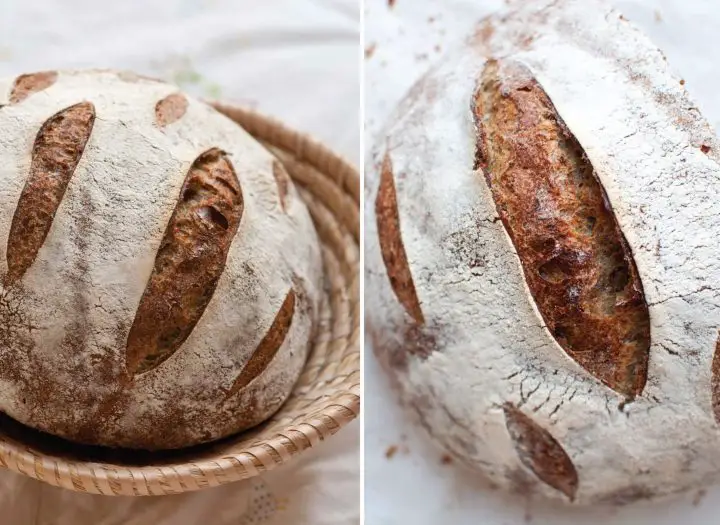
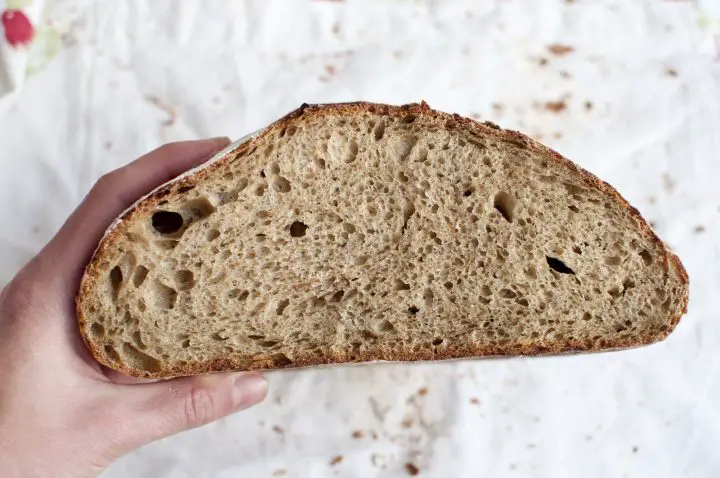

You can also use pumpkin in sourdough pumpkin rolls, and the flour in whole wheat sourdough bread.
What inspires you to bake sourdough bread? Did you try making this pesto bread recipe using pumpkin seeds or other seeds? What are some of your delicious recipes for pesto bread?
FAQs
How do you make sourdough bread more flavorful?
Keep in mind that the flavor of sourdough bread can vary based on many factors, such as the flour used, the temperature and humidity of the environment, and the feeding schedule of the starter. It may take some experimentation to find the flavor profile that you prefer.
You can try using a mature starter, extending the fermentation time, baking with different flours, adding flavor and toppings, adjusting the hydration level, and baking at a higher temperature.
Does pesto go with sourdough bread?
Yes, pesto can be a delicious accompaniment to sourdough bread! Sourdough bread has a tangy flavor that pairs well with the savory and slightly sweet flavors of pesto. The texture of sourdough bread, with its crispy crust and chewy crumb, also provides a great contrast to the smooth and creamy texture of pesto.
You can use pesto as a topping or spread the pesto on your sliced sourdough. You can also try incorporating pesto into the recipe, like in this blog post.
Why not try adding extra virgin olive oil on your delicious baked bread dough for an extra oomph?


![[Video Tutorial] How To Make Amazing &Amp; Simple Gluten-Free Sourdough Bread – Secret Process Revealed 111 [video tutorial] how to make amazing & simple gluten free sourdough bread – secret process revealed](https://www.mydailysourdoughbread.com/wp-content/uploads/2022/11/image-13-120x120.jpeg)

